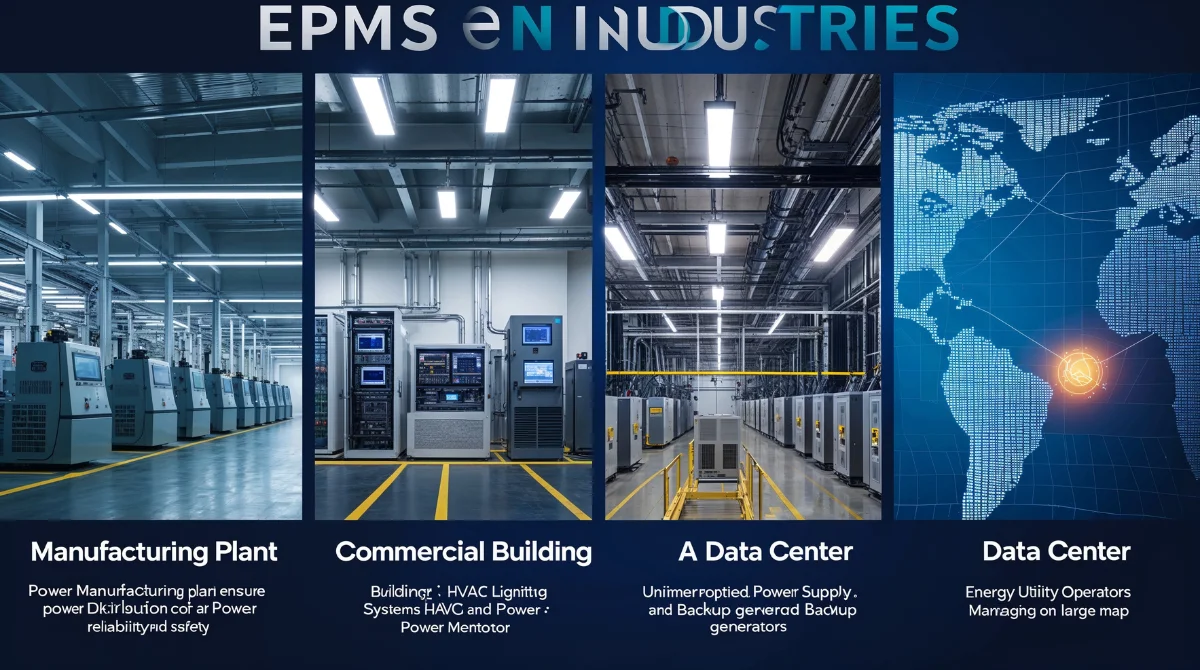Organizations want efficient solutions to monitor and manage their electrical power systems in a time when energy efficiency and consumption are crucial. One such solution that aids companies and industries in effectively tracking and managing electrical energy usage is an Electrical Power Monitoring System (EPMS). EPMS is crucial for preventing power outages, ensuring that electrical systems are running at peak efficiency, cutting expenses, and improving general safety. This essay will discuss EPMS’s definition, salient characteristics, advantages, and critical function in energy management.
What is an Electrical Power Monitoring System (EPMS)?
One tool that tracks and evaluates electrical power systems’ performance in real time is an Electrical Power Monitoring System (EPMS). In order to monitor power consumption, voltage levels, frequency, and other parameters, it gathers data from a variety of electrical devices, including transformers, generators, circuit breakers, and meters. Enhancing the power system’s dependability and efficiency is the main objective of an EPMS, which aids businesses in better energy management while guaranteeing the security of electrical infrastructure.
A wide range of industries, including utilities, commercial buildings, and manufacturing, use EPMS. It gives operators the information they need to maximize energy use, minimize downtime, and guarantee that electrical systems are operating at peak efficiency. Organizations can proactively identify and resolve power quality issues before they become serious ones by utilizing EPMS.
How Does EPMS Work?
Continuously collecting real-time data from a variety of electrical components, including transformers, circuit breakers, meters, and generators, is how an Electrical Power Monitoring System (EPMS) operates. This system combines software that processes and analyzes the data with hardware, like sensors and meters. This is how it operates:
- Data Collection: Important characteristics including voltage, current, frequency, power factor, and energy usage are among the data that EPMS gathers from electrical equipment. The constant nature of these measurements guarantees that the system offers real-time information on the electrical system’s operation.
- Data Transmission: After being gathered, the data is sent to a cloud-based platform or central control unit. Because this transfer occurs in real-time, operators can instantly access the data via dashboards or mobile applications.
- Data Analysis: Complex algorithms are used to process the gathered data in order to find trends and anomalies in the electrical system. For instance, abrupt voltage spikes, frequency imbalances, or unusual energy use that would point to a possible malfunction or inefficiency can all be detected by EPMS.
- Alerting and Notifications: EPMS sounds an alert or sends out a notification whenever it finds any problems or possible flaws. Operators may take corrective action before the issue worsens because they are promptly notified by emails, SMS, or on-screen notifications.
- Reporting and Visualization: Dashboards in EPMS software provide a clear and easy-to-use visual representation of key data metrics. Operators may monitor power quality, overall system performance, and trends in energy use with these dashboards. Comprehensive reports can also be produced for decision-making, regulatory compliance, or additional analysis.
- Predictive Maintenance: EPMS can forecast when electrical equipment is likely to go down or need maintenance by examining historical data. This enables companies to carry out preventative maintenance, which lowers unscheduled downtime and increases the longevity of vital equipment.
Key Features of EPMS
1. Real-Time Monitoring
An EPMS’s real-time electrical system monitoring capability is among its most important characteristics. Operators can promptly see any anomalies or problems in the system thanks to EPMS’s real-time data on voltage, current, power factor, and energy consumption. This real-time input guarantees that remedial measures may be implemented quickly, averting expensive equipment damage or downtime.
2. Data Logging and Analysis
Electrical data is continuously logged by EPMS, enabling historical analysis. Businesses can find patterns and make wise decisions by using EPMS, which stores data on power usage, energy consumption trends, and system performance. This historical data can eventually be utilized for predictive maintenance, extending the life of electrical equipment and averting future problems.
3. Load Management
One of EPMS’s most important features is load management. It assists businesses in making sure that electricity is distributed equally among various circuits and equipment and that their electrical systems are not overburdened. In order to maintain optimal system performance and avoid overload scenarios that could result in system failures, EPMS can monitor load demand and assist operators in modifying power distribution.
4. Alarm and Notification System
Operators are informed of anomalous conditions or possible electrical system problems via EPMS systems’ alarm and notification features. For instance, the system will notify users by email, SMS, or other channels if voltage levels fall or if equipment works outside of safe bounds. By assisting operators in reacting quickly to problems, these alarms lower the possibility of system failures and enhance operational safety.
5. Power Quality Analysis
Any electrical system must have high-quality power, and EPMS is essential for tracking and guaranteeing the power’s quality. Sensitive equipment performance may be impacted by power quality metrics that are measured by EPMS systems, including harmonic distortion, voltage sags, and spikes. Early detection of these problems helps EPMS maintain a steady power supply and minimize harm to machines.
6. Energy Efficiency Optimization
Optimizing energy efficiency is one of EPMS’s main advantages. By analyzing power usage data, EPMS can pinpoint areas where energy use can be reduced. To assist businesses lower their energy expenses and carbon footprint, it can automatically modify settings or recommend power-saving techniques.
7. Reporting and Dashboard
User-friendly dashboards that offer a visual depiction of both historical performance measurements and real-time data are commonly included in EPMS systems. These dashboards make it simple for managers and operators to view vital data, like equipment status, cost savings, and trends in energy consumption. Furthermore, EPMS has the ability to produce comprehensive reports that are useful for analysis, decision-making, and energy regulation compliance.
8. Integration with Building Management Systems (BMS)
To manage energy and facilities in a unified manner, EPMS can be combined with pre-existing Building Management Systems (BMS) or other automation platforms. Organizations can gain more control over their energy use and make sure that power consumption complies with both operational requirements and environmental objectives by integrating electrical power monitoring with environmental control systems (such as HVAC and lighting).
Benefits of EPMS
1. Cost Savings
EPMS assists companies in identifying inefficiencies and cutting waste by offering insights into patterns of energy consumption. Organizations can lower operating costs and energy bills by utilizing technologies like load management and energy efficiency optimization. Since these savings can add up over time, EPMS is a good investment for any company trying to better control its power consumption.
2. Improved System Reliability
By offering real-time data and warnings that enable the early detection of defects and other problems, EPMS improves the dependability of electrical systems. Businesses can prevent expensive repairs and guarantee that their electrical systems continue to function by spotting issues before they result in equipment failure or downtime. As a result, the organization’s overall power supply becomes more steady and dependable.
3. Predictive Maintenance
EPMS assists companies in making the transition from reactive to predictive maintenance by analyzing past data and patterns. EPMS enables prompt action before concerns worsen by spotting patterns that point to possible problems. In the long run, this proactive strategy lowers repair and replacement expenses by extending the life of electrical equipment.
4. Regulatory Compliance
Many enterprises are subject to stringent regulations on energy use, environmental effect, and power quality. By offering comprehensive reports on energy consumption, system performance, and power quality, EPMS assists companies in ensuring adherence to these standards. Businesses can use this information to show their dedication to environmental sustainability and energy efficiency, which can improve their company’s reputation and help them avoid penalties.
5. Enhanced Safety
Any electrical system must be safe, and EPMS contributes to safety by offering real-time monitoring and warnings of potentially hazardous situations. EPMS assists in preventing electrical mishaps, equipment damage, and fires by guaranteeing that voltage, current, and other parameters remain within acceptable ranges. Because of the system’s early fault detection capabilities, operators can take corrective action before a safety concern escalates into a major issue.
6. Environmental Sustainability
In order to lessen a company’s environmental effect, EPMS is essential. Through waste reduction and energy optimization, EPMS assists companies in lowering their carbon footprint. Contributing to a better future in sectors where sustainability is a top priority, EPMS assists businesses in coordinating their operations with environmental laws and corporate sustainability objectives.
Real-World Applications of EPMS

Electrical power systems are monitored and managed by EPMS in a variety of sectors. Here are a few typical uses for EPMS:
1. Manufacturing
Industrial facilities utilize EPMS to monitor power consumption across a variety of devices and processes. It assists in making sure that machinery runs within ideal bounds, reducing energy waste and equipment damage. Additionally, EPMS helps to reduce downtime, increase production efficiency, and ensure a steady power supply to vital machinery.
2. Commercial Buildings
EPMS assists in controlling the power consumption of HVAC systems, lights, and other electrical loads in large commercial buildings. EPMS can lower energy expenses while maintaining occupant comfort in the building by managing energy utilization. Additionally, it assists facility managers in adhering to sustainability and energy efficiency laws.
3. Data Centers
Critical IT infrastructure is housed in data centers, which greatly depend on a steady and reliable power source. By keeping an eye on power systems, EPMS makes sure that all equipment has constant power and that backup generators are prepared to start during blackouts. By preventing downtime, EPMS helps data centers stay open around-the-clock.
4. Energy Utilities
EPMS is used by energy utilities to track and optimize the grid’s electricity distribution. Operators can find inefficient locations and improve grid performance by using the data it offers on power generation, transmission, and distribution. Utility businesses can achieve regulatory requirements for power quality and reliability with the aid of EPMS.
Key Differences Between EPMS and Other Management Systems
While an Electrical Power Monitoring System (EPMS) is specialized in managing electrical power systems, it differs significantly from other management systems such as Enterprise Resource Planning (ERP), Building Management Systems (BMS), and Manufacturing Execution Systems (MES). Here are some examples of how EPMS distinguishes itself and performs exceptionally well:
- Focus Area: Power consumption, power quality, and overall system efficiency are the main areas of attention for EPMS, which is especially made to control and monitor electrical systems. ERP, BMS, and MES are examples of other systems that support more general business purposes. BMS regulates building automation systems (HVAC, lighting, security), MES supervises manufacturing production processes, while ERP concentrates on managing firm resources like finance, inventories, and human resources.
- Real-Time Electrical Monitoring: Operators may make prompt decisions to address inefficiencies or avert possible breakdowns thanks to EPMS’s comprehensive, real-time data on power consumption, voltage, frequency, and current. On the other side, ERP and BMS systems don’t keep such a close eye on electrical systems; instead, they concentrate on other operational facets (such financials or facilities management).
- Power Quality Management: EPMS has capabilities specifically designed to analyze and manage power quality, including the ability to identify harmonics, voltage spikes, or sags that may have an impact on operations and equipment. Other systems, such as ERP or MES, lack these features since they don’t monitor electrical metrics or power quality-related problems.
- Electrical Infrastructure Predictive Maintenance: EPMS is a master at predictive maintenance for electrical equipment, utilizing previous data to anticipate possible electrical breakdowns and suggest preventative actions. This contrasts with ERP and MES, which are not experts in electrical infrastructure and often manage the upkeep of more generic resources (such as machinery or human resources).
- Energy Efficiency Optimization: Improving the electrical system’s energy efficiency is the only emphasis of EPMS By keeping an eye on trends in energy usage, it can suggest corrective actions to optimize energy use and reduce waste.
EPMS is more specialized for businesses trying to efficiently manage energy use because other management systems, such as ERP or BMS, typically do not concentrate on energy consumption.
FAQ
1. How does an EPMS operate and what is it?
To guarantee effective energy use and system dependability, an Electrical Power Monitoring System (EPMS) is a tool that continuously monitors, evaluates, and improves electrical power systems.
2. What are the main advantages of EPMS use?
Cost savings, increased system dependability, predictive maintenance, energy efficiency optimization, and improved safety are just a few advantages that EPMS provides.
3. In what ways might EPMS help reduce energy costs?
By analyzing patterns of energy consumption and spotting inefficiencies, EPMS assists companies in maximizing power use, cutting waste, and eventually lowering energy costs.
4. Is it possible to combine EPMS with additional management systems?
In order to manage energy consumption and facility operations in a unified manner, EPMS can be coupled with Building Management Systems (BMS) and other automation platforms.
5. In which industries can EPMS be used?
Manufacturing, commercial buildings, data centers, and energy utilities are just a few of the industries that use EPMS to effectively monitor and control electrical power systems.
Conclusion
For contemporary businesses trying to maximize their electrical power consumption, enhance system dependability, and cut expenses, the Electrical Power Monitoring System (EPMS) is a crucial instrument. EPMS gives organizations the information they need to efficiently manage their energy use by providing real-time monitoring, predictive maintenance, power quality analysis, and energy efficiency optimization. Whether in data centers, commercial buildings, or manufacturing, EPMS assists businesses in maintaining a steady, dependable, and economical power system while promoting environmental sustainability. Any company looking to stay ahead in the energy-conscious world of today would be wise to invest in an EPMS.



